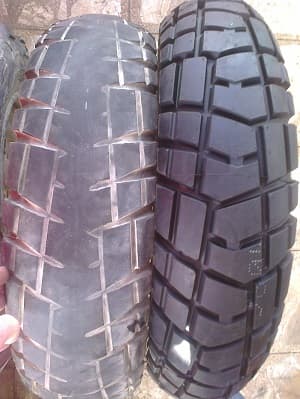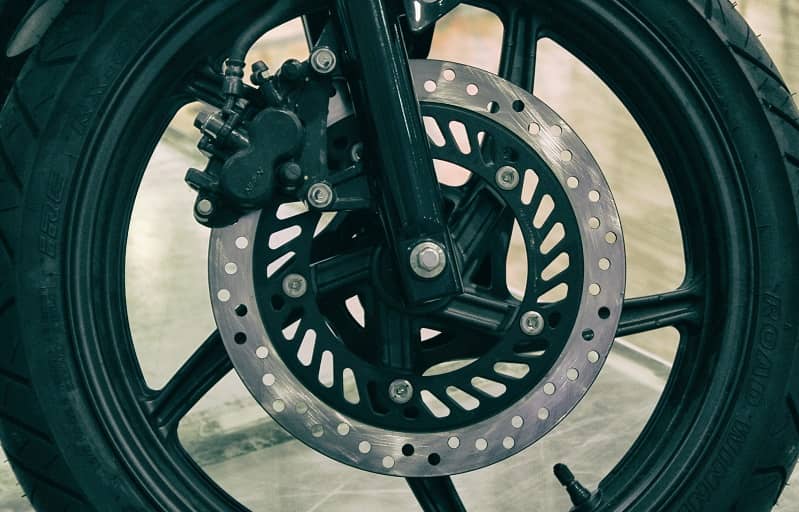Some riders will avoid riding in the rain; they don’t want to subject themselves or their motorcycle to the wet weather.
Others ride all year, no matter the weather, as their bike is their only form of transport.
Riding in the rain doesn’t need to be intimidating or uncomfortable.
There are some key tips you can follow to make sure you are safe while out on the road.
Let’s take a look at 7 of our top tips for riding in the rain:
Save Money On Your Motorcycle Insurance
- You could pay less than £195*
- Compare quotes from 25+ UK providers
- Fill in one form to compare top bike insurers
Prepare your motorcycle
Tyres

The absolute number one thing to check when preparing to ride in the rain is to make sure your tyres have tread.
This could mean you have to swap out your slick track tyres for wet weather or all-year tyres with suitable tread.
A tyre’s tread channels water away; there is more surface of your tyre in touch with the actual road surface and, therefore, more traction. Slick tyres don’t do this as the aim of the game with these is to go as fast as possible – not something you are aiming for in the wet.
Ensure your tyres are also inflated to the correct pressure and that there is not much wear on one section of the tyre, as this can be problematic.
Brakes

Check that your brakes are in working order and that your brake pads are good and not worn down.
If you are on a modern motorcycle, you will likely have ABS. This is your best friend in all weather but particularly the rain, where it will help keep you balanced and safe when braking hard, even in the wet.
Lights
Always check your lights and your indicators before you go out for a ride. The rain makes you less visible on the road to other road users, and working lights will help you to be seen.
Check for oil leaks
An oil leak can be annoying and messy in normal dry conditions; in wet conditions, it can be a recipe for disaster.
Even the smallest oil leak can mean the oil combines with the wet, and this can make your ride slippy, which is all sorts of dangerous!
Wear appropriate riding gear
Once you’ve prepared your bike, the next thing to do is prepare your gear. The proper riding kit in the rain can make the difference between a fun ride and a miserable one.
Fortunately, we have covered some of the best waterproof gear currently available, so here is what you need if you regularly ride in poor weather:
You can find really good waterproof kit for all budgets and circumstances.
One thing to be aware of is that the best option for wet weather riding is Gore-Tex lined kit. From gloves to boots, Gore-Tex is guaranteed to keep you dry and let you breathe at the same time.
Rukka makes some of the best all-weather Gore-Tex gear. They are at the high-end of the price range, so may not be for everyone. However, for a motorcycle instructor, all-weather commuter, blood biker etc., gear from Rukka should be considered an investment. This stuff will keep you dry and protected in all weather. Check out our guide to the best Goretex jackets.
You could also consider motorcycle rain suits (one and two-piece suits are available). They are ideal for throwing over your regular riding gear as a waterproof layer.
They pack down pretty small and are easy to stow in your top box, ready for when you need them. This is a good option if you don’t plan to ride in the rain but get caught on occasion.
Waterproof your luggage
If you are carrying stuff around with you, remember you need a waterproof luggage system; the last thing you want is for your work laptop to get wet.
You can get waterproof backpacks that will do this job well. Hard luggage with waterproof liners is a good shout but also, in a pinch, black bin liners can also do the job.
Prepare your helmet
Your best bet in the rain is to wear a full-face or modular helmet.
Not only do these offer more protection in an accident than an open-face helmet, but they can also keep the rain from getting your head and face wet.
There are, of course, a few problems that can crop up when riding with a helmet in the rain.
Visor

In the rain, your visor is more prone to fog up and block your vision. However, many helmets now come with a Pinlock compatible visor, which is the best way to prevent this issue.
A Pinlock insert sits inside your visor and absorbs the moisture inside the helmet to keep your visor clear.
Having excellent visibility in the rain is essential.
Using a water repellant on your helmet is a great way to ensure the rain doesn’t settle and simply beads off.
You can also get gloves with a small silicon blade on the thumb, which acts like a window wiper allowing you to clear your visor on the move.
Vents
Another point you will want to be aware of is your helmet vents. Closing all your vents will lead to moisture build-up from your breath and condensation on your visor, but it will keep the rain out.
However, opening the vents front and back will allow cool air to flow in and warm air to be expelled, keeping your visor clear.
The downside is that the rain can get in.
Your best option to minimise getting soaked is to half close the vents at the front, but keep your exhaust vents open as these ensure the air flows through the helmet.
Plan your route
This one is simple, make sure you know where you are going and are aware of any issues you may face on the way due to the rain, such as floods and road closures.
Check the weather report for the day of your ride and ensure you take the best route, given the circumstances.
If heading out on a long ride, a good idea is to plan plenty of rest stops along your route, where you can go and get a tea/coffee, get warm and have some respite from the weather.
Riding in the rain can feel more fatiguing, so the extra breaks will benefit you greatly.
Be aware of how the rain affects the roads
When the roads are wet, there are increased hazards. By being aware of these, you can avoid them and ride safely.
- Painted lines get increasingly slippy; if you can avoid these, then do so. If not, slow down and ride smoothly over them. Avoid braking where possible on any painted surfaces. Manhole covers, metal covers, and rainbow-coloured puddles are also best avoided.
- Heavy rainfall will cause oils to rise to the surface of the road, which is most prevalent during the first hour of rain. Ideally, avoid riding during this time. If you have to ride, take it steady and ride behind other vehicles’ tyre tracks, as this will increase your traction with some of the water already out the way.
- Increase your braking distances so you can brake slow and steady. Use a light hand on your front brake, you will brake slower than usual, but you can compensate for this by increasing your braking distance.
- If the weather takes a worse turn and there is lightning, you should take cover immediately. Water conducts electricity, you will be wet, your bike will be wet, and the rubber tyres won’t protect you, so get off the road and let the storm pass.
- The rain will cause puddles on the road, which can block potholes and other hazards from being seen. Extra caution should be taken when riding through puddles, so you don’t hit something unexpectedly.
Increase observations and make yourself seen
I say it every year as soon as the weather turns for the worse, the first bit of rain, and nobody remembers how to drive.
Read how to ride a motorcycle in winter
You need to ride your motorcycle with the mindset that every other vehicle is out to get you, and they can not see you.
The rain certainly hinders visibility, so you need to make sure you are doing extra checks ahead of time at junctions, roundabouts etc. also, you need to go out of your way to make sure you are visible on the road.
For some, this may mean wearing high viz vests; others might opt for a white helmet or put reflectors on their bike.
Whatever you are comfortable with doing to increase your visibility, if you are riding in the wet regularly, this is when these things will benefit you most.
Relax
Above everything else, you need to relax when riding. If you are riding your motorcycle tense, stiff and worried, this will translate to your machine and increases the risk of an accident.
You just need to stay calm and ride loose like any other riding day.
The facts are you know how to ride a motorcycle, and you will be as prepared as you can be, so you need to trust yourself and your bike.
Slow things down slightly, increase your observations and stopping distances but other than that, try to ride as you always would and enjoy it.

